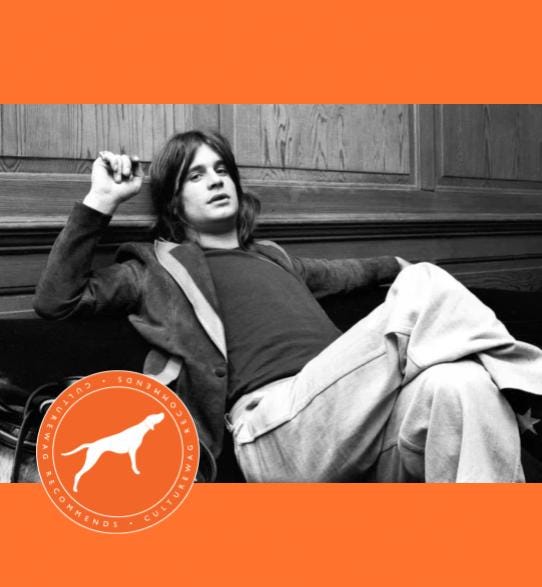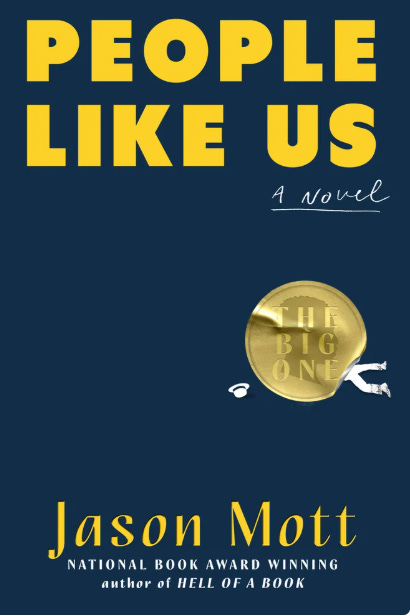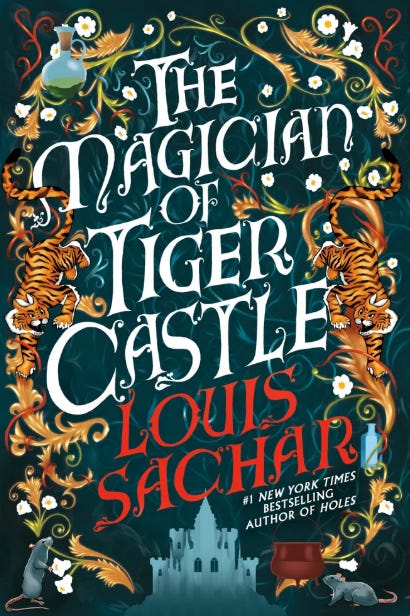Hello, Smarty—It's Your BookWag!
The Music Desk Tears Into Another Riff for Ozzy. Plus: New Reads From Elaine Castillo, Katie Yee, Louis Sachar, Jason Mott, Thomas Chatterton Williams, and More...
Dear Wags,
Ozzy Osbourne knew that high up in his obituary—before the black magic nonsense and the reinvention as a befuddled reality TV father—would come the bat. The limp, lifeless thing was tossed onstage at a 1982 concert in Des Moines. “I thought it was one of these toy bats,” he said. “I picked it up, bit the thing’s head off, and suddenly everybody’s freaking out because it’s a real bat…. I can assure you, the rabies shots I went through after were no fun.”
The bat incident, alongside a gruesome episode involving two dead “doves of peace” Ozzy brought to a meeting with record execs (legend has it he bit off their heads when negotiations went south), made him a sinister figure to moral crusaders of another era. It was good for the brand. Offstage, Ozzy—at least to those of us who met him a bit later—was a simple working-class bloke from Birmingham. A family man and homebody—even if his home was in Beverly Hills and the mortgage was paid by a long, lucrative run playing Satan’s errand boy. Enfeebled by his battles with addiction and later Parkinson’s disease, he was a defanged hellhound. No, a pussycat. Bats and other innocent creatures had nothing to fear.
The stagecraft didn’t fully convey just how volatile and damaged Osbourne truly was during his wild years as the frontman of Black Sabbath, the band he formed with Tony Iommi, Geezer Butler, and Bill Ward in 1968. His appalling misbehavior defined Sabbath nearly as much as his reedy wail. The band fired him in 1979 (though they’d reunite several times). He later admitted to years of manic, violent antics—including killing cats in a drug-fueled frenzy, a grotesque act that marked a turning point in his struggle with addiction and mental illness. With the help of his manager and second wife, Sharon, he got treatment and mounted multiple career revivals.
Last week’s Osbourne eulogies overlooked how central he was to a forgotten subculture of the 1980s. Most of his best music was made with Sabbath, but Ozzy hit his theatrical peak as a solo artist, hamming it up as every mother’s nightmare and a bad influence to middle schoolers the world over. Wayward boys who grew up in 1980s suburbia played air guitar to the infectious opening riff of “Crazy Train”—a propulsive, unforgettable burnout anthem.
Nobody remembers burnouts these days. They wore their hair unfashionably long and feathered it, 1970s-style. Their uniform consisted of heavy metal concert T-shirts, flannel shirts, and ratty denim jackets. They hung out in high school parking lots and outside convenience stores, getting high. They didn’t get punk, and they hated disco and New Wave. But they worshipped heavy metal. In the affluent, aspirational Reagan/Bush years, they were blue-collar misfits—a rebuke to a shiny, striving, Don’t Worry, Be Happy ethos. Ozzy was their hero.
Unlike punks, burnouts weren’t glamorized rebels in the popular culture of their day. They pop up here and there—Judd Nelson’s dirtbag loner in The Breakfast Club, the aimless dupes manipulated into murder in To Die For, assorted freaks in Freaks and Geeks—but mostly, they’ve been disrespected and ignored. Around the time Ozzy sank his teeth into that bat, they were cast as villains during a wave of Satanic Panic.
Punk made a few inroads outside major urban centers, but burnouts—also known as burners or stoners—were everywhere: in dying Rust Belt towns, in drab Western exurbs, in small communities deep in the Bible Belt. If rap gave voice to inner-city rage and pride, metal was the outlet for blue-collar white kids who felt shut out of the American dream. They surfaced in tabloid stories about ritual murder and the devil’s music, culminating in cases like the West Memphis Three, where teenagers were wrongly imprisoned for nearly two decades on flimsy, panic-driven evidence. Their eventual release was a reckoning with the hysteria and prejudice of that era.
Ozzy, Sabbath, Judas Priest, Slayer, Mötley Crüe, and other metal bands were at the center of those lurid controversies—a target of evangelical moralists and the Parents Music Resource Center, led by Tipper Gore. Then as now, hand-wringing about lost young men was a cultural fixation. But in those days, it wasn’t the internet triggering fear and suspicion—it was drugs, metal, and Dungeons and Dragons.
There was always a class element to the vilification of the burnout. Many of the kids who found an outlet in heavy metal came from the wrong side of town; they were the greasers of S.E. Hinton’s The Outsiders. Their aimlessness ran counter to American success worship. But burnouts weren’t overeducated Gen X slackers working as baristas and reading Proust. Slacking implies having opportunities to pass by.
Ozzy wasn’t a devil worshipper. He was a showman, and his antics spoke powerfully to confused adolescents. Theatrical lawlessness, staged sadism and sexual bravado, playing guitar licks with your tongue or a rolled-up sock in your trousers, the secret messages from Lucifer hidden on vinyl and only audible in reverse—all of it spoke to frightened little boys fumbling their way toward manhood. The strutting and preening in spandex was a cousin of professional wrestling.
Like wrestling, the main victims were the performers themselves, who often wrecked their lives trying to embody life in the fast lane. Ozzy’s days as a tabloid sensation cost him dearly. By the time he gained renewed fame alongside his family in MTV’s The Osbournes (2002–2005), he bore the scars of years of hard living. His shuffling incoherence was played for laughs, but it was also the early toll of Parkinson’s disease.
When Ozzy died at 76 on July 22, from complications related to a long-debilitating illness, he had already spent years in a wheelchair. Though he only went public with his diagnosis in 2020, he’d been living with it for nearly two decades. At his final public appearance—a Sabbath concert at London’s Villa Park on July 5—he sat onstage in a bat-motif throne. By then, the Prince of Darkness routine had long since mellowed into harmless camp.
Nobody used the term manosphere in 1983, but if it had existed, Ozzy would have been sucked into it. He had a genius for poking the establishment in the eye—or yanking down his trousers and making a mess on its lawn—that appalled the right people and delighted outsiders. That same streak of defiance shows up in today’s testosterone-fueled influencers.
But even the most determined bad boy grows up. The dyslexic son of factory workers with a talent for make-believe, Ozzy found his way to the circus the only way he could—by acting out. After nearly destroying himself, he survived by embracing the role of a good-natured survivor, a semi-retired vampire who wiled away the daylight hours on the couch, in his socks, with a cup of tea, watching Aston Villa on the telly.
Ozzy didn’t invent teen rebellion, but he was one of its great innovators. For every snarling misfit who felt too dumb, too weird, or too poor to matter, he was proof that being feral could still make you a star. Long after he was over the hill, he kept at it with a twinkle in his eye. Satanism was never rampant in Britain or America, but spectacle is in our DNA. Moral panics come and go, but the Devil—that old devil—always packs the house.
Yours Ever,
John Bender
People Like Us by Jason Mott
Mott’s 2021 National Book Award winner, Hell of a Book, gave the world Soot—a Black kid growing up in North Carolina who finds refuge in a world of stories. His narrative was ingeniously threaded into the misadventures of a novelist on a book tour. Without giving too much away, People Like Us brings Soot back: now an author in midlife, wrestling with a tragic past and shivering through a frigid Midwest tour to promote his latest book.
There’s also a second, dueling narrative—this one following a younger, hipper Black writer on a more glamorous European junket, his head turned by literary fame. The double-barreled structure and a few callbacks echo Hell of a Book. Still, this story stands on its own as a clever, often hilarious reflection on being a Black writer (the younger character doesn’t mind being mistaken for Ta-Nehisi Coates).
Layered into the metafictional fun is a meditation on how gun violence haunts American life—material that might have felt heavy-handed in lesser hands. But Mott is a dazzling, daring virtuoso.
— Sintara Golden
The Magician of Tiger Castle by Louis Sachar
Sachar, the beloved author of Holes, brings fairy tale whimsy to his first novel for adults. The magician of the title narrates this fanciful yarn, set 500 years ago in the kingdom of Esquavita (now just another tourist trap somewhere south of France). There, a familiar dilemma unfolds: Princess Tullia has been promised to the unlovable heir of a neighboring royal house to secure a political alliance—but her heart belongs to Pito, the court scribe.
The king and queen order Anatole, a has-been sorcerer who has known and loved Tullia all her life, to use his magic to convince her to accept the arranged marriage. The cleverness here is that Sachar puts the aging magician—not the young lovers—at the center of the fable. If Anatole succeeds, he may revive his sagging career. But it means betraying the happiness of someone he truly cares for.
You’ll root for him to make the right call—but you’ll also understand why it’s not an easy one. The result is a wry, charming, and just-grown-up-enough tale.
—Meg Murray
Keep reading with a 7-day free trial
Subscribe to CultureWag to keep reading this post and get 7 days of free access to the full post archives.






